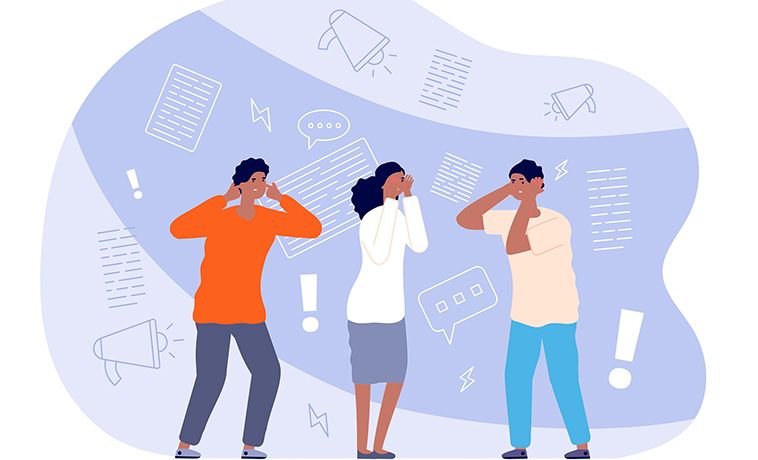How Political Messages Spread—and Why We Believe Them

How do political narratives—true or not—take root and spread? That’s the question driving the scholarship of Chris Wells, an associate professor of emerging media studies. Long before “fake news” and “alternative facts” entered our lexicon or the Washington Post fact-checkers gave out their first Pinocchio, Wells was digging into the reasons we hold the political beliefs we do and the ways news media—and, eventually, social media—contribute to that.
In 2016, Wells quantified, for example, the signal boost that then-candidate Donald Trump received from traditional news outlets publishing and broadcasting his tweets. Today, armed with an Institute for Global Sustainability grant, Wells is leading a team researching the ways interest groups use disinformation to create confusion in discussions about climate change—and the types of messages that might break through that noise. And heading into a nail-biter midterm election with political division and animosity seemingly everywhere, the work is as important than ever.
From Advocacy to the Academy
In the early 2000s, Wells was working as a fellow with the Washington Public Interest Research Group, an environmental advocacy group based in the Pacific Northwest. He helped plan public events and researched environmental topics for elected officials, but it was his work trying to get reporters to write about the ecological threats of overfishing in the North Pacific that deepened his interest in how political messages are crafted—and when and why media pick up certain stories.
“Journalists understood [the issue of overfishing], but to have it seriously covered was a real challenge,” he says. “The difficulty of convincing the press to cover the issues that we were concerned about definitely made an impression.”
Wells was also paying attention to a 2004 presidential election in which political smears against candidate John Kerry may have helped reelect George W. Bush—even with the balance of information beginning to suggest he’d taken the US to war under false pretenses. The book Mediated Politics: Communication in the Future of Democracy also deeply affected Wells and made him aware of the growing area of study known as political communication. “It was speaking to things that felt a lot closer to what I was actually seeing than what I’d experienced before,” he says.
One of the book’s co-editors, W. Lance Bennett, taught political communication nearby, at the University of Washington. Wells enrolled, eventually completing a master’s degree in communication and a PhD, during which he had a front-row seat for an expanding internet culture and early iterations of social media networks—which he says formed within a culture of skepticism that was challenging the legitimacy of legacy media.
The internet was fertile ground for casting doubt on legacy media as being “corporate-controlled,” Wells says, adding that “the idea was that on the internet they could go and find their own truths, and they could find what was real to them, and they didn’t have to be constrained by these established media.” The mirror image of that ideal, whether it pertains to elected officials, climate or vaccines, is what Wells says we’re grappling with today—and it’s what he’s devoted his career to understanding.
COM in the Center for Data & Computing Sciences
Chris Wells is a founding member of the Faculty of Computing & Data Sciences, but he’s not the only COM connection to BU’s massive investment in big data.
Chris Chao Su, an assistant professor of emerging media studies, is a faculty fellow on the BU Faculty of Computing and Data Sciences. He analyzes data from social media measurement tools to explore how audiences take shape in an increasingly fragmented digital media environment.
The Justice Media co-Lab is a collaboration between COM’s journalism department, BU Spark! and the Center for Computing & Data Sciences. It brings together students with backgrounds in journalism and the computing and data sciences to work on computational journalism projects in partnership with external media partners like the Boston Globe and The Bay State Banner
How Political Narratives Develop
Political messages take shape within what Wells calls a hybrid media system. Some messages start at the top, with a president delivering a memorable speech—such as Barack Obama’s concession remarks after losing the New Hampshire Democratic primary during the 2008 presidential election. The ideas he shared there about race and progress, including the memorable and repeatable “Yes we can!” mantra, helped Obama win the presidency.
These more traditional political messages are increasingly boosted in online spaces, ranging from the “Obama Girl” YouTube video that went viral in 2007 to darker far-right organizing and meme-boosting happening today on platforms like 8Chan, Discord and Reddit. Candidates and special interests exploit both ends of this hybrid system. Wells has studied the role Donald Trump’s Twitter feed played in the 2016 Republican primary, finding that he masterfully uses social media to his advantage. Wells and his fellow researchers showed a correlation between higher volumes of Trump tweets and retweets and coverage in the legacy media. A separate study showed that through February 2016, news stories about Trump’s tweets helped the candidate get more earned media than rivals Hillary Clinton and Ted Cruz combined—earned media worth an estimated $2 billion. This resulted in more Americans seeing Trump’s tweets in news reports than on Twitter itself, dramatically increasing his reach.
At the same time, face-to-face conversation in the grocery store produce section or between neighbors over the fence remains a crucial place where information (and misinformation) is shared and messages are boosted, Wells says. “People make sense of the world by talking to each other in casual contexts, sometimes about politics, explicitly, and sometimes more generally about, ‘where did you get cheap gas?’” These encounters are a hotbed for misinformation, he adds, because we often incorrectly assume that our experience of the world represents a statistical reality.
Recently, Wells shifted his focus from politics to another contentious issue: climate change. Funded through a 2022–2023 Focused Research Program grant from BU’s Institute for Global Sustainability, in partnership with the Rafik B. Hariri Institute for Computing and Computational Science & Engineering, Wells is coleading a research team with Irena Vodenska, professor and director of MET finance programs, and Sarah Finnie Robinson, a senior fellow at the BU Institute for Global Sustainability and adjunct clinical professor at COM. The team will be aided by four other BU researchers, including two from COM: Arunima Krishna and Michelle Amazeen.
If you favor a particular policy or candidate or position, you can reason back from that to believing something that supports it, even if that information isn’t true.
Chris Wells
They are trying to understand the role of communication in shaping public opinion on climate in the US. The yearlong study will examine the issue in three “thrusts”: how climate disinformation spreads through social media; how native advertising—paid content that mimics news articles—is employed for corporate communication campaigns; and the influence of disinformation on public attitudes, including intervention strategies that may effectively dispel misperceptions about climate change. For example, he wonders how the electric Ford Lightning pickup truck might help soften the views of men, especially in rural areas, who he says tend to be the most skeptical of climate change.
“One of the things I’m most interested in doing is figuring out how identity comes to bear on some of these questions,” Wells says. “Climate is clearly a highly polarized issue right now. Apart from partisanship, which is kind of obvious, what other aspects of people’s identities are elicited by the climate issue?”
Why We Believe the Spin
Scholars are settling on some key answers to the question of why we’re prone to believe misinformation in politics, Wells says. For one, our brains do not always process information in a rational, evidence-to-conclusion progression; sometimes we start with a conclusion and accept evidence that supports it. “If you favor a particular policy or candidate or position, you can reason back from that to believing something that supports it, even if that information isn’t true,” Wells says.
Furthermore, our commitments to those conclusions tend to be especially strong when they are associated with an identity we hold closely, Wells says. These identities include political parties as well as cultural, regional and racial categories. “We understand politics in social group terms,” he adds, encountering a new message, issue or leader with the question, “Is this person or idea from my group, from one of the groups who are aligned with my group, or from one of the groups that aren’t aligned with my group?” And we often view news stories through this prism as well, deferring to political and media voices we trust or identify with to interpret what we’re seeing and reading. For instance, Wells and his colleagues examined hundreds of articles, television news segments and Facebook posts for four days in April 2020 and found that outlets covered mostly the same big stories relating to the emerging COVID-19 pandemic, but differed in how they interpreted events. Take the infamous press conference where former President Trump suggested that household disinfectant might be effective at treating the coronavirus. Wells and graduate students Briana Trifiro (’23) and Alex Rochefort (’22) showed that Fox News covered Trump’s press conference as extensively as any other outlet, but their analysts were more likely to frame and interpret the event in terms that were favorable to the former president than those on MSNBC.
“It’s not that people on the right don’t know that Trump said something ridiculous about bleach,” Wells says. “They have an interpretive framework, which is aided by the news media, which gives them a suite of ways to understand” such a statement. Some might justify it as “just a joke” or intended to “rile up the liberals.”
Catastrophic Consequences
Our tendency to start with a political conclusion and collect evidence that supports it has proven to be dangerous to democracy. In 2019, a bipartisan Senate Intelligence Committee declared that Russia had waged a campaign to spread disinformation on social media in an attempt to influence the 2016 presidential election and create confusion and division in the US electoral system: mainstream news outlets had picked up and boosted rumors and false reports that had been intentionally planted by Russian intelligence.
“Russia is waging an information warfare campaign against the US that didn’t start and didn’t end with the 2016 election,” wrote Sen. Richard Burr (R–N.C.). “Their goal is broader: to sow societal discord and erode public confidence in the machinery of government. By flooding social media with false reports, conspiracy theories and trolls, and by exploiting existing divisions, Russia is trying to breed distrust of our democratic institutions and our fellow Americans.”
We like to think about information as something that’s really great, and people use it to update their beliefs. But in politics, it’s not nearly that straightforward.
Chris Wells
On a smaller scale, political forces have been sowing political disinformation since the first election was held—even in local and state-level initiative campaigns. In 2009, a University of Washington research team of which Wells was a part found that in typically nonpartisan ballot questions—where residents vote to repeal or create a policy—voters are routinely misinformed by special interest groups who stand to gain or lose from the adoption of a particular law. Wells’ team showed that even the most sophisticated voters have formed views on a topic that are based on false information.
In fact, the study found that more politically knowledgeable voters had more information than other voters, but they were more systematically misinformed as a result. “It was a bit of a cautionary tale about the role of information,” Wells says. “We like to think about information as something that’s really great, and people use it to update their beliefs. But in politics, it’s not nearly that straightforward.”
In the wake of Russian disinformation and widespread misinformation about COVID-19, nearly half of Americans said in 2021 that they believe the government should take steps to restrict false information online—even if that means limiting free speech—a 10 percent increase since Pew Research Center last asked US adults about it in 2018.
Finding a Silver Lining
Prefacing any optimism with the observation that America may be on the verge of a constitutional crisis, Wells sees reason to hope the media and political landscape will improve. For one, Americans may not be as divided as our discourse, a point he says is laid out in the new book The Other Divide: Polarization and Disengagement in American Politics, by Yanna Krupnikov and John Barry Ryan.
“The people who spend all their time on Twitter and reading the New York Times are pretty polarized politically. They have the strongest attitudes,” filtering out conservative views and talking the most in person and online, Wells says, summarizing a few of the book’s findings. “But as [Krupnikov and Ryan] show, most citizens don’t hold terrible animosity toward the other side, most of them don’t have super echo-chambery networks, and there’s a lot of effort to get along.”
Combating widespread misinformation in the future may begin with reconstructing solidarity where there is division, Wells says. For Americans who tend to consume news stories and political messages through the lens of the social group with which they identify, highlighting different identities to which people can associate—like being a working person or a parent, for instance—may help bridge the gap.
“I think there’s some hope that we will find ways not to be drawn into these kinds of polarizations, but I think that we really do need ways of presenting communications to citizens that help to build cross-group solidarity and help to find those identities that we share in common,” he says.
Whatever happens, make no mistake: Wells says he will be watching the trends and working toward a political communication culture where truth wins the day.


